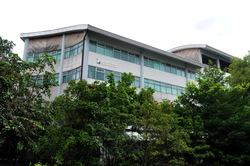
The Forest Herbarium building on the 3rd-5th floor
Forest Herbarium

61 Phahonyothin Road
Ladyao
Chatuchak
Bangkok
10900.0
Thailand
Dr. Rachun Pooma
Email: rpooma@dnp.go.th
Nannapat Pattharahirantricin, Curator
Email: np_pat@hotmail.com
BKF (the Forest Herbarium) or Office of the Forest Herbarium is under the auspices of the Department of National Parks, Wildlife and Plant Conservation (DNP) which was separated from the Royal Forest Department (RFD) in 2002. The DNP is an implementing agency for the forest and wildlife policies covering both ex-situ and in-situ conservation in Thailand through national parks, wildlife sanctuaries, and forest research institutions including BKF.
BKF undertakes research on plant and fungal taxonomy, forest ecology, ethnobotany and conservation biology. The aims and duties of the Forest Herbarium include the following activities:
- Conduct botanical inventories, collect plant specimens and undertake plant taxonomic research for the "Flora of Thailand Project", in collaboration with Japanese, Danish, Dutch and Brittish botanical institutes. An important aspect of this task is maintenance of the Forest Herbarium.
- Survey and classification of forest types in Thailand. Based on ground surveys, Thai forests are described with respect to their structure and species composition. The purpose of this is to identify silvicultural priorities, economic plants and to strengthen conservation management.
- Establish contacts and make the collections available for groups dealing with conservation and protected area management, silviculturists and ecologists, wildlife experts and lay people, and facilitate their research activities within Thailand.
- Supervise management and research of botanical gardens and arboreta located throughout Thailand.
We are Thailand's biggest herbarium and a centre of scientific excellence in taxonomic and biodiversity research. The BKF contains an international collection of over 200,000 preserved specimens, mainly of flowering plants and ferns collected in the country. Specimens collected are dealt with in two ways, one is their input onto a plant database system to make information more accessible, the other is for a database with pictures of specimens on CD-ROM, undertaken as part of "The Princess Maha Chakri Sirindhorn Project on Plant Genetic Resources Conservation".
